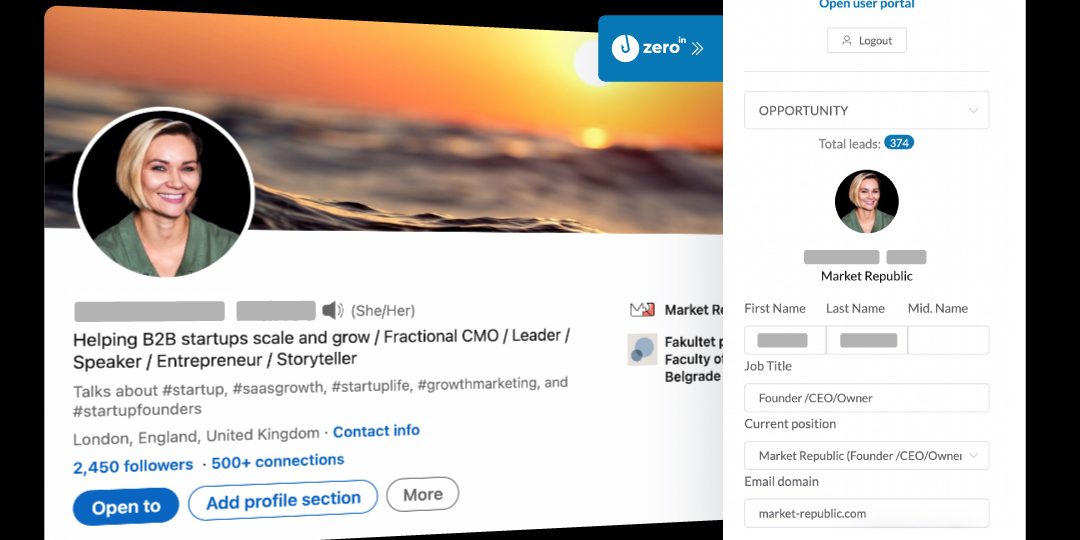We have prepared all the info any sales team needs to master the art of categorizing your leads. Keep reading and lead like a pro.
Summary
In this article, we will discuss the importance of categorizing leads and mastering the art of lead management. We will cover different lead categories, the funnel, BANT criteria, and how to disqualify leads with red flags.
As a bonus, we will also make sure to introduce a light CRM tool to help you categorize your leads effectively.
How did the lead come to us?
The first step in categorizing new leads is checking whether they’re inbound or outbound leads, dictated by the way in which they have come to you.
Knowing the lead origin is super important for lead categorization because it will give you a better understanding of where they stand. This will ensure that you react timely, ultimately helping you increase your revenue.
Inbound
Inbound leads have expressed some type of interest in your product, or in other words, they have initiated the content and come to you, usually through digital marketing efforts.
Typically, they have filled out a form on your website, subscribed to your newsletter, or downloaded a free resource — it’s what you think of when you hear the words B2B lead generation strategy. They could also come organically via social media platforms such as Facebook, Twitter or Instagram.
These prospects are already aware of who you are. They likely already trust you. Because they have come to you, it’s likely that your product/services solve one of their pain points, and that the timing is right and we may even call them sales qualified leads (SQLs).
As such, it may be easier to sell to inbound leads — but your lead nurturing process will require a more personalized approach. You already know they’re interested in your offering so you can tailor your communication to them specifically.
Outbound
You yourself have reached out to outbound leads through cold calling or emailing, advertising via social media platforms such as Facebook, Twitter, Instagram, etc. You have initiated the contact.
These prospects don’t know who you are. It is your task to introduce yourself and your products or services. You’ll also need to put in more effort to establish a connection and build trust.
Since you don’t know if they’re interested or have a need for what you’re selling, the communication you send tends to be less personalized. You have to be engaging and informative without being too salesy, making the lead nurturing in this case a bit more difficult.
What are Hot Leads?
Hot leads have a high likelihood of becoming a customer. They have shown a high level of interest in your business and usually, they are farther along in the funnel.
These leads may have contacted you asking for more info, engaged with your newsletters or your social media content, or even just spent significant time on your website researching your offering.
Hot leads take priority in every B2B lead generation strategy because they’re most likely to convert.
What are Cold Leads?
On the other hand, cold leads require more nurturing. They have shown little to no interest in your product or service, and they are far from ready to buy.
You may have sourced them from an email list vendor or through an email-finding tool from a lead generation company, or you’ve reached out to them through a cold call or email marketing.
Cold leads will require more time and effort on your part to nurture and engage them, to hopefully earn their trust and sell your offering if the conditions get met.
Categorization by the place in the Funnel
The Funnel is a visual representation of the customer journey.
Usually, it spans from the initial awareness stage, or the top of the marketing funnel, to the final purchase, or the bottom of the funnel. You can categorize leads and customize your communications according to their stage in the funnel to easily move them to the bottom through the sales cycle.
We always recommend consulting an expert and setting up marketing automation tools to automate the lead classification process.

Top of the Funnel
The leads in the Top of the Funnel (TOFU) stage can be referred to as cold leads. TOFU is also known as the awareness stage.
Your leads may have just learned about your brand and they are just starting to explore the options. TOFU is the earliest stage in the buying process and these leads will require additional nurturing and brand education.
Leads in this stage of the marketing funnel can be considered marketing qualified leads (MQLs) ready to be exposed to your digital marketing efforts.
Middle of the Funnel
The leads in the Middle of the Funnel (MOFU) stage can be referred to as warm leads. MOFU is also known as the consideration stage.
Your leads have identified a need or a problem they’re trying to solve, and they have actively started to research different solutions. At this point, they have likely already engaged with your brand by signing up for a newsletter, downloading a free resource, or attending a webinar.
MOFU leads have therefore already shown some interest in your organization, but you’ll need to nurture them further to move them through to the bottom of the funnel.
Bottom of the Funnel
The leads in the Bottom of the Funnel (BOFU) stage can be referred to as hot leads or sales qualified leads (SQLs). BOFU is also known as the decision stage, the crucial part in the sales cycle.
Your leads are ready to make a purchase. They have researched their options and they have to make a decision. It’s your job here to ensure they choose your brand over your competitors.
BANT
BANT is a lead qualification framework or a set of lead qualification criteria that helps companies laser focus on prospects highly likely to convert instead of wasting time on leads that aren’t a good fit for their product.
It is an acronym that stands for Budget, Authority, Need, and Timescale, the four criteria the BANT system uses to qualify leads.
Budget
Can your lead afford your product or service?
That’s the main question that you should answer for this criterion. If not, you really shouldn’t spend valuable time nurturing them.
Depending on your ideal customer profile, note that a certain type of companies such as public companies, universities, etc, plan out their yearly budgets well in advance. If you’re late to the party, save that lead for the right time next year.
Authority
Does your lead have the authority to make the decision to purchase your offering?
This criterion refers to the lead’s decision-making power within their business. If your lead doesn’t have it, still try to get them on your side as a “product champion” and ask them to set you up with the decision maker.
Note that usually the bigger the company, the more people are required to make that decision so the process may take longer than expected.
Need
Does your product or service solve the lead’s pain point?
To purchase from you, it should solve a problem the lead has.
If this is not the case, it means that you’re not the right fit for each other.
Timescale
When is your lead planning to make the purchase?
This will greatly help you understand your lead’s priorities as well as prioritize your leads on your side.
If your lead is trying to solve the problem they have asap, you can consider them a warm lead that you have to convince to purchase from you. On the other hand, if your lead doesn’t have any space in the budget or if the budget has been pre-planned in advance, you’ll be better off focusing on others for the time being.
How to Disqualify Leads – Red Flag Alert
Disqualifying leads is just as important as qualifying them in a lead generation strategy. Knowing when to step down will do wonders for your efficacy.
When engaging with your leads, pay attention to the red flags such as a lack of pain points, authority, and enthusiasm. If you catch them on time and disqualify your leads, you’ll save time.
👉 If your product doesn’t solve any problem your lead has, then it’s best to step down. Your time would be much better spent talking to someone whose need your product actually addresses.
👉 If your lead doesn’t have the power to make the purchasing decision, deprioritize them. If they can get you in touch with the decision-maker, they’re still a valuable asset.
However, if they don’t have enough influence on them, it’s time to disqualify them.
👉 Out of politeness, leads may often express enthusiasm about your product even if that’s not actually the case. It’s up to you here to tell true and fake enthusiasm apart.
Conclusion
Optimize your sales process and increase your revenue by properly categorizing your leads. It may seem complicated at first, but once you have it set up, you’ll be glad you did it.
Start by setting up your CRM. If you don’t have yet one, ZeroIn offers a light CRM perfect for SMBs that lets you save, manipulate, and edit your contacts.

But that’s not all: because ZeroIn comes with a 200M business contact database, you’ll even be able to use it to verify or enrich your existing data. Isn’t that awesome?
And don’t even get started on the free LinkedIn and Sales Navigator email finding browser extension…
What is ZeroIn?
Introducing ZeroIn: an all-in-one email discovery solution, complete with a streamlined CRM for effortless organization and management of valuable prospect data. Beyond essential contact details like business emails and phone numbers, ZeroIn uncovers over 20 additional insights related to your contacts and their companies.
Effortlessly integrated with your Free or Sales Navigator LinkedIn searches, ZeroIn empowers your outreach through a browser extension that applies your search criteria and harnesses its vast database to present a complete picture of your potential clients.
ZeroIn goes beyond the ordinary by delivering up to 26 unique data points, including verified business emails, outshining conventional data such as phone numbers and email addresses. Our exclusive 10-step verification process guarantees the accuracy and legitimacy of every email address you encounter.
Moreover, ZeroIn enables you to import and re-verify existing email lists, and conveniently export leads in versatile formats like CSV, XLS, and Google Drive.
For those times when you need a quick assessment, ZeroIn’s “single email verification” feature offers rapid, reliable checks on individual email addresses. Elevate your prospecting game with ZeroIn – the ultimate tool for email discovery and management.
How can ZeroIn help your business?
ZeroIn helps you boost your outreach and sales by streamlining prospect list building. You can find and verify prospect email addresses in a click, both individually and in bulk while keeping your CRM data clean through the duplicate finder.
Because it offers a lifetime, pay once, and use forever deal, ZeroIn is ideal for SMBs in the growth stage.
Create a Free Account and Get 25 credits!
FAQ
By what parameters can you sort out leads?
There are a couple of different ways that you can sort out your leads:
👉 Cold or hot lead: cold lead requires nurturing before making the purchase, while hot lead is ready to commit.
👉 Lead origin: inbound leads have initiated the contact and come to you, while you have reached out to outbound leads first.
👉 Sales funnel: top, middle, and bottom of the funnel with each stage representing a place in the buyer journey.
👉 BANT: lead qualification system that takes into consideration the lead’s budget, authority, need, and timescale.
What are Cold and Hot leads?
Cold leads require further nurturing and education before they purchase your product or service. On the other hand, hot leads are ready to make the decision and should be your priority.
Categorization by origin of the lead?
You can categorize leads by their origin: inbound or outbound.
Inbound leads have expressed some interest in your brand, usually by filling out a form on your website, subscribing to your newsletter, or downloading a free resource. They have some awareness of your brand. They are much closer to being a sales qualified lead (SQLs) than outbound leads who are typically marketing qualified leads (MQLs).
Outbound leads are the ones you’ve reached out to first, usually through a cold call or email marketing. They have no awareness of who you are and can therefore be considered colder.
Categorization by the place in the funnel?
You can categorize leads by their place in the sales funnel: top of the funnel, middle of the funnel, or bottom of the funnel.
The top of the funnel (TOFU) consists of cold leads in the awareness stage who have just started learning about your brand.
The middle of the funnel (MOFU) consists of leads in the consideration stage who have identified a problem they have that you help solve. They’ve started to research their options.
The bottom of the funnel (BOFU) consists of leads in the decision stage. They’re deciding which product to with and it’s up to you to convince them.
BANT?
BANT is lead qualification criteria that take into consideration the lead’s budget, authority, need, and timescale.
Budget refers to whether a lead can afford our product or service.
Authority refers to a lead’s decision-making power within the company.
Need refers to the lead’s pain points and how our offering addresses them.
Timescale refers to the lead’s timeline for making a purchase.
What are Red Flags?
Red flags are pointers that it may be time to disqualify a lead as they signal that the lead isn’t very likely to convert. The biggest red flags include a lack of pain points, authority, and enthusiasm.
